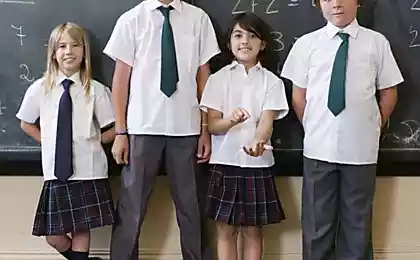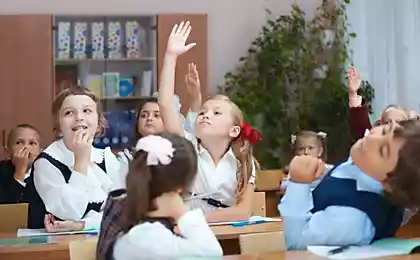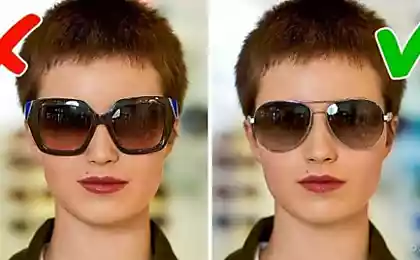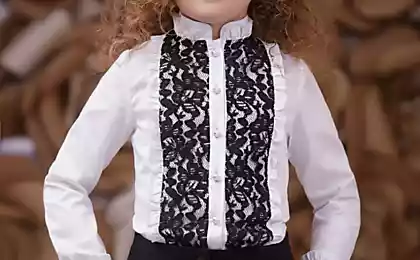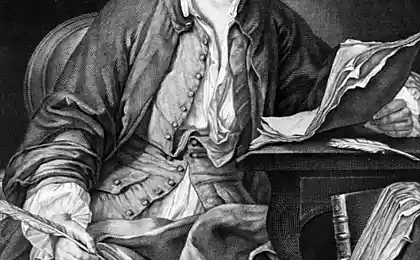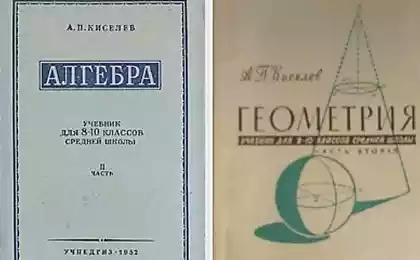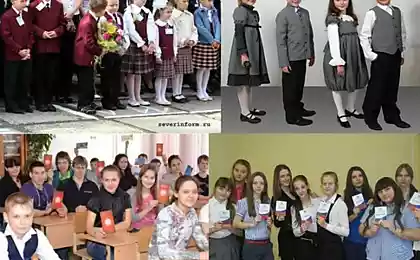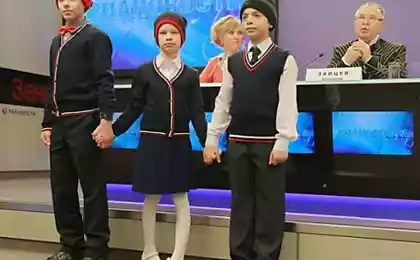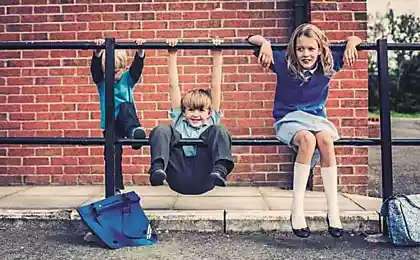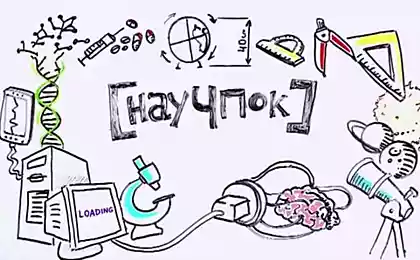1328
From the history of school uniforms
7 photos + text
Author: horror1017
At school uniforms in Russia's rich history. Back in 1834 a law was passed that approved the general system of civilian uniforms in the empire. This system includes the gymnasium and student uniforms. And in 1896 there was a provision on the form of the high school for girls. The pupil of the famous Smolny Institute instructed to wear dresses of certain colors, depending on the age of the pupils. For pupils 6 - 9 years - brown (coffee), 9 - 12 years old - blue, 12 - 15 years old - gray and 15 - 18 years old - white.
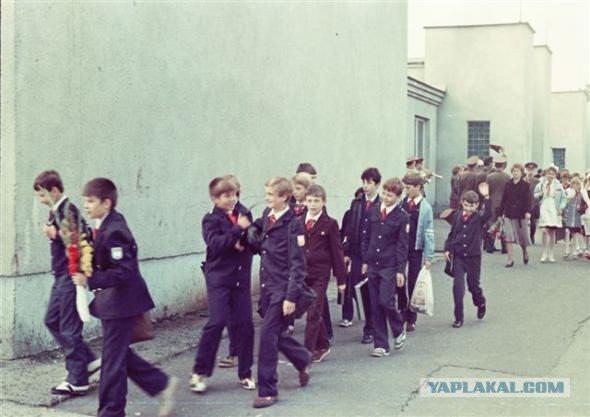
Until 1917, the form was a sign of caste, because afford the tuition at school could only children of rich parents. Form worn not only in the walls of the institution, but also on the street, at home, during the festivities. The boys wore uniforms of the military style, and girls relied dark strict dress with pleated skirts to the knee.
However, shortly after the revolution, in the struggle against bourgeois vestiges and heritage tsarist police regime in 1918 was issued a decree abolishing the wearing of school uniforms. Undoubtedly, in the early years of the Soviet state school uniforms was a luxury in a country ravaged by world war, revolution and civil war.
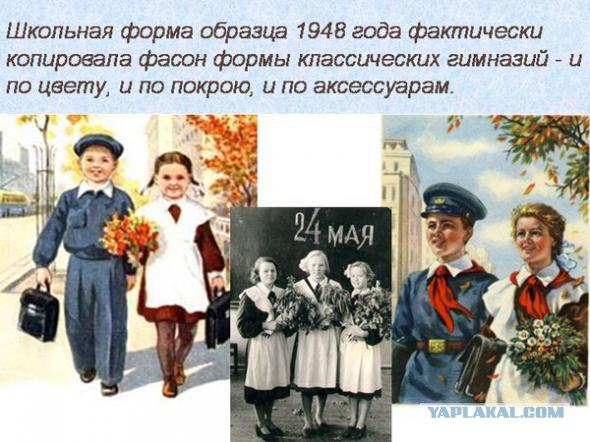
School uniform again becomes mandatory only after the Great Patriotic War in 1949 in the Soviet Union introduced a school uniform. From now on, the boys had to wear a military tunic with collar small stands and the girls - brown wool dress with a black apron.
Dresses were modestly decorated with lace collar and cuffs. Wearing a collar and cuffs was mandatory. In addition, the girls could wear black or brown (daily) or white (ceremonial) bows. Bows of other colors according to the rules were not allowed. It is worth noting that in the general school uniform for girls Stalinist era was like a school uniform Tsarist Russia.
The strictness of morals spread of the Stalin era, of course, and school life. Most minor esksperimenty with a length or other parameters of school uniforms severely punished the administration of the institution.
Even hairstyle should meet the requirements of the Puritan morality - "model haircuts" to the end of the 50s were strictly prohibited, not to mention the color of the hair. The girls wore braids necessarily with bows.
Uniforms Stalin era can be seen in the films "grader", "Alyosha Ptitsyn produces character" and "Vasek Trubachev and his comrades»
In addition, after the war was introduced separate education from which a few years later, however, refused.
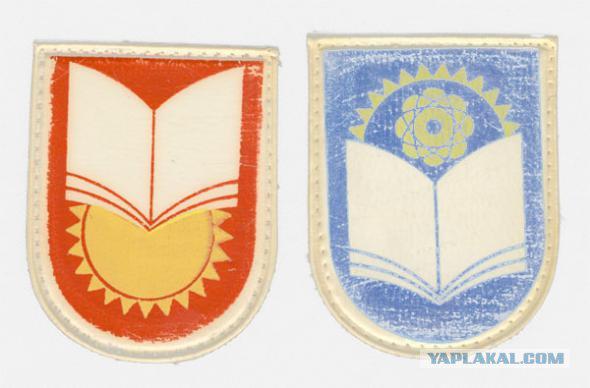
In 1970, the charter secondary schools existed as a school uniform mandatory.
"Warming" mode is not immediately affected the democratization of school uniforms, but it still happened.
Cut shapes became more identical to those fashion trends that have taken place in the 1960s. However, only the lucky boys. The boys from the mid-1970s gray wool trousers and jackets were replaced by trousers and jackets in wool blend fabrics blue. Tailoring jackets reminiscent of classic denim jackets (in the world gained momentum so-called "Denim»).
On the side of the sleeve was sewn emblem of soft plastic with painted open textbook and the rising sun.
School children of the late 1960s, we can see in the cult film "We'll Live Till Monday».
In the early 1980s, was introduced form for high school students. (This form began to carry the eighth grade). Girls from first to seventh grade wore a brown dress, as in the previous period. Once it was slightly above the knee.
The boys trousers and jacket were replaced by a pantsuit. Fabric color was still blue. Also, the blue was the emblem on the sleeve.
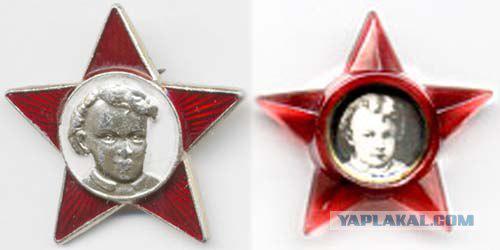
Very often an emblem cut because it did not look too aesthetically pleasing, especially after some time - the paint on the plastic starts to blur.
For girls in 1984, was introduced three-piece suit of blue, consisting of a skirt with pleats trapezoid front jacket with patch pockets and vests. Skirt can be worn either with a jacket or vest with or whole suit immediately. In 1988, for Leningrad, Siberia and the Far North were allowed to wear blue pants in the winter.
Some Soviet republics style school uniforms a bit different, as well as color. So, Ukraine school uniform was brown, though not prohibited and blue.
It is this form for girls contributed to the fact that they began to realize early in its appeal. Pleated skirt, vest and most importantly - blouses, with which you can experiment, turned almost every schoolgirl in the "young lady».
Addition to the mandatory school uniform, depending on the age of the student, were oktyabryatsky (in primary school), Pioneer (in middle school) or Komsomol (in high school) icons. Pioneers were also to be sure to wear Pioneer tie.
Apart from the usual pioneer icon there was a special option for the pioneers who are actively engaged in social work. He was a little more than usual, and on it was written "For active work».
Uniforms of the 1980s can be seen, for example, in the film "Guest from the Future" and "The Adventures of Electronics»
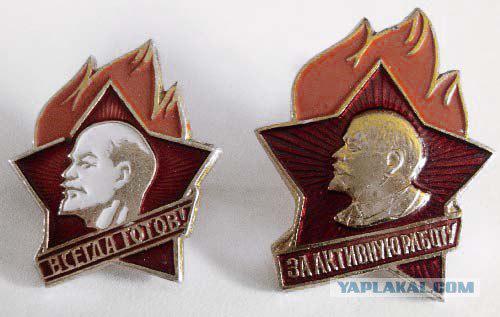
Years pass, and in 1991 there is still a school uniform. Gradually uniforms underwent changes and becomes a little more free.
School uniform was abolished only in 1992 by the decision of the Government of Russia, with the introduction of the new Education Act.
To date, the question for wearing school uniforms solved at the level of educational institutions, leaders and parents. No official documents, orders, instructions to the mandatory school uniforms no.
Nevertheless, more and more educational institutions are turning to past experience and introduce school uniforms as a mandatory attribute of school life.
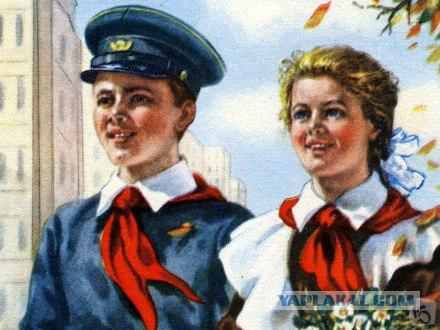
School uniforms in other countries different from ours: in some places it is more conservative, but somewhere - very trendy and unusual. For example, in Japan schoolgirl flaunt sailor, called it "Sailor Fuku". Their shape - the standard of teenage fashion for the whole world. Even outside the school Japanese are something that reminds them their usual uniforms.
In Cuba, the form is mandatory for all schools and higher education institutions.
In the UK, the most conservative school uniform and close to the classic style of clothing. Each school has a prestigious logo, so the students are required to attend classes with the "brand" tie.
In France, a school uniform policy existed from 1927 to 1968. In Poland - until 1988
In Germany, there is no single school uniforms, although there is a debate about its introduction. In some schools, students can participate in the development of school clothes. Characteristically, even during the Third Reich students do not have a single form.
In the US, each school decides what things are allowed to put on the students. As a rule, is prohibited in schools tops, opening the abdomen, as well as low-set pants. Jeans, slacks with lots of pockets, shirts with graphics - that American schools prefer students.
In most European countries there is also no single form, all limited to a relatively strict style. In many countries, the issue of school uniforms, as we have, remains open.
At school uniforms have opponents and supporters. Modern teenage students in the majority strongly opposed. Parents and teachers, on the contrary, advocated the introduction of this element, trusting that the school uniform:
discipline students (business style requires students to the rigor and discipline)
smoothes the social differences between students,
helps to keep the distance between students and teachers.
allows you to track school "outsiders»
does not allow teenagers to dress provocatively.
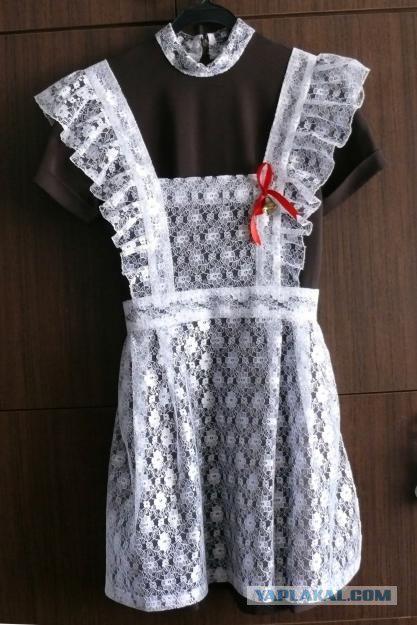
Source:
Author: horror1017
At school uniforms in Russia's rich history. Back in 1834 a law was passed that approved the general system of civilian uniforms in the empire. This system includes the gymnasium and student uniforms. And in 1896 there was a provision on the form of the high school for girls. The pupil of the famous Smolny Institute instructed to wear dresses of certain colors, depending on the age of the pupils. For pupils 6 - 9 years - brown (coffee), 9 - 12 years old - blue, 12 - 15 years old - gray and 15 - 18 years old - white.

Until 1917, the form was a sign of caste, because afford the tuition at school could only children of rich parents. Form worn not only in the walls of the institution, but also on the street, at home, during the festivities. The boys wore uniforms of the military style, and girls relied dark strict dress with pleated skirts to the knee.
However, shortly after the revolution, in the struggle against bourgeois vestiges and heritage tsarist police regime in 1918 was issued a decree abolishing the wearing of school uniforms. Undoubtedly, in the early years of the Soviet state school uniforms was a luxury in a country ravaged by world war, revolution and civil war.

School uniform again becomes mandatory only after the Great Patriotic War in 1949 in the Soviet Union introduced a school uniform. From now on, the boys had to wear a military tunic with collar small stands and the girls - brown wool dress with a black apron.
Dresses were modestly decorated with lace collar and cuffs. Wearing a collar and cuffs was mandatory. In addition, the girls could wear black or brown (daily) or white (ceremonial) bows. Bows of other colors according to the rules were not allowed. It is worth noting that in the general school uniform for girls Stalinist era was like a school uniform Tsarist Russia.
The strictness of morals spread of the Stalin era, of course, and school life. Most minor esksperimenty with a length or other parameters of school uniforms severely punished the administration of the institution.
Even hairstyle should meet the requirements of the Puritan morality - "model haircuts" to the end of the 50s were strictly prohibited, not to mention the color of the hair. The girls wore braids necessarily with bows.
Uniforms Stalin era can be seen in the films "grader", "Alyosha Ptitsyn produces character" and "Vasek Trubachev and his comrades»
In addition, after the war was introduced separate education from which a few years later, however, refused.

In 1970, the charter secondary schools existed as a school uniform mandatory.
"Warming" mode is not immediately affected the democratization of school uniforms, but it still happened.
Cut shapes became more identical to those fashion trends that have taken place in the 1960s. However, only the lucky boys. The boys from the mid-1970s gray wool trousers and jackets were replaced by trousers and jackets in wool blend fabrics blue. Tailoring jackets reminiscent of classic denim jackets (in the world gained momentum so-called "Denim»).
On the side of the sleeve was sewn emblem of soft plastic with painted open textbook and the rising sun.
School children of the late 1960s, we can see in the cult film "We'll Live Till Monday».
In the early 1980s, was introduced form for high school students. (This form began to carry the eighth grade). Girls from first to seventh grade wore a brown dress, as in the previous period. Once it was slightly above the knee.
The boys trousers and jacket were replaced by a pantsuit. Fabric color was still blue. Also, the blue was the emblem on the sleeve.

Very often an emblem cut because it did not look too aesthetically pleasing, especially after some time - the paint on the plastic starts to blur.
For girls in 1984, was introduced three-piece suit of blue, consisting of a skirt with pleats trapezoid front jacket with patch pockets and vests. Skirt can be worn either with a jacket or vest with or whole suit immediately. In 1988, for Leningrad, Siberia and the Far North were allowed to wear blue pants in the winter.
Some Soviet republics style school uniforms a bit different, as well as color. So, Ukraine school uniform was brown, though not prohibited and blue.
It is this form for girls contributed to the fact that they began to realize early in its appeal. Pleated skirt, vest and most importantly - blouses, with which you can experiment, turned almost every schoolgirl in the "young lady».
Addition to the mandatory school uniform, depending on the age of the student, were oktyabryatsky (in primary school), Pioneer (in middle school) or Komsomol (in high school) icons. Pioneers were also to be sure to wear Pioneer tie.
Apart from the usual pioneer icon there was a special option for the pioneers who are actively engaged in social work. He was a little more than usual, and on it was written "For active work».
Uniforms of the 1980s can be seen, for example, in the film "Guest from the Future" and "The Adventures of Electronics»

Years pass, and in 1991 there is still a school uniform. Gradually uniforms underwent changes and becomes a little more free.
School uniform was abolished only in 1992 by the decision of the Government of Russia, with the introduction of the new Education Act.
To date, the question for wearing school uniforms solved at the level of educational institutions, leaders and parents. No official documents, orders, instructions to the mandatory school uniforms no.
Nevertheless, more and more educational institutions are turning to past experience and introduce school uniforms as a mandatory attribute of school life.

School uniforms in other countries different from ours: in some places it is more conservative, but somewhere - very trendy and unusual. For example, in Japan schoolgirl flaunt sailor, called it "Sailor Fuku". Their shape - the standard of teenage fashion for the whole world. Even outside the school Japanese are something that reminds them their usual uniforms.
In Cuba, the form is mandatory for all schools and higher education institutions.
In the UK, the most conservative school uniform and close to the classic style of clothing. Each school has a prestigious logo, so the students are required to attend classes with the "brand" tie.
In France, a school uniform policy existed from 1927 to 1968. In Poland - until 1988
In Germany, there is no single school uniforms, although there is a debate about its introduction. In some schools, students can participate in the development of school clothes. Characteristically, even during the Third Reich students do not have a single form.
In the US, each school decides what things are allowed to put on the students. As a rule, is prohibited in schools tops, opening the abdomen, as well as low-set pants. Jeans, slacks with lots of pockets, shirts with graphics - that American schools prefer students.
In most European countries there is also no single form, all limited to a relatively strict style. In many countries, the issue of school uniforms, as we have, remains open.
At school uniforms have opponents and supporters. Modern teenage students in the majority strongly opposed. Parents and teachers, on the contrary, advocated the introduction of this element, trusting that the school uniform:
discipline students (business style requires students to the rigor and discipline)
smoothes the social differences between students,
helps to keep the distance between students and teachers.
allows you to track school "outsiders»
does not allow teenagers to dress provocatively.

Source:

